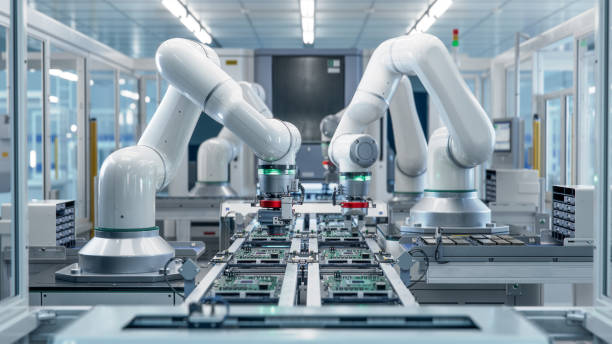The field of automation and robotics is undergoing a dramatic change. The intriguing union of printed circuit boards (PCBs) and mechatronics engineering is at the core of this transformation. Everything is evolving because of this powerful combination of hardware board design, making and operating smart robots. A mix of high-tech electronics, and computerized and mechanical systems, is heralding an unimaginable world of innovation when it comes to manufacturing floors, home helpers and beyond. Engineers, manufacturers and enthusiasts of technology need to understand these new trends which are numerous to keep abreast in this dynamic field.
- Miniaturization Magic: Shrinking Components for Maximum Impact
The design of robotics has been transformed by the unrelenting search for more compact and potent parts. These days, modern PCBs can fit extremely small yet immensely powerful CPUs, sensors, and actuators in small packages. Engineers may now design more streamlined robotic systems without compromising functionality because of the trend toward downsizing. More effective use of board real estate is made possible by advanced manufacturing processes that enable component placement with microscopic accuracy. This way smaller, more agile robots can operate in some places previously inaccessible to larger machines. Within medical robotics, where significant tools have to operate within sensitive biological conditions using minimal invasiveness, this revolution of downsizing manifests itself greatly.
- Flexible Circuit Solutions: Bending the Rules of Traditional Design
Rigid design limitations are being lifted by flexible PCBs, providing robotic architecture with previously unheard-of flexibility. Without severing connections, these flexible circuits can adjust to dynamic mechanical motions, fold over obstructions, and conform to curved surfaces. In articulated robotic joints, where conventional rigid boards would break under repetitive stress, this flexibility is very useful. In order to create more dependable and integrated systems, engineers may now route electrical channels via intricate mechanical assembly. Flexible circuits are perfect for applications needing millions of operating cycles because of their resilience to continuous motion. Everything from wearable automation gadgets to robotic arms is changing as a result of this innovation.
- Smart Material Integration: When Electronics Meet Advanced Materials
Robotic systems that are sensitive and adaptable are being created by combining PCB technology with smart materials. Conductive polymers, piezoelectric materials, and shape-memory alloys are being included straight into circuit board designs. When exposed to mechanical stress, temperature changes, or electrical impulses, these materials can alter their characteristics. Robots may now display more realistic behaviors, such self-healing or adaptive stiffness control, thanks to this integration. Engineers are finding novel ways to integrate materials with autonomous sensing, actuation, and response capabilities with electrical circuits. More intelligent hardware that can adjust to shifting circumstances without the need for intricate programming or external control systems is the end result.
- Wireless Connectivity Revolution: Cutting the Cord for Greater Freedom
Robots are becoming freed from the limitations of physical connections thanks to wireless communication technology. Advanced wireless modules integrated into contemporary PCBs allow for smooth connection between external systems and robotic components. The wireless revolution offers a more flexible pcb design board and allows the sensor, actuator and control modules to be distributed around the mechanical structure. Real-time data sharing among components provides intelligent decision-making and the coordination of movement. By doing away with heavy cable harnesses, dependability is increased while weight and mechanical complexity are decreased. In swarm robotics, where several autonomous units must coordinate their activities via wireless networks, this development is especially revolutionary.
- Energy Harvesting Innovations: Powering Robots from Their Environment
Robots are changing how they get and use electricity thanks to energy collecting technologies. Advanced circuits that can harvest energy from motion, vibration, heat, and light sources in the robot’s operational environment are now integrated onto PCBs. Longer operating times are made possible by this self-sustaining method, which lessens reliance on conventional batteries. Robotic movement’s kinetic energy may be transformed back into electrical power to build more effective systems. Circuit board designs are increasingly including vibration harvesters, solar cells, and thermoelectric generators. For autonomous robots working in distant areas where battery replacement is prohibitive or unattainable, this invention is very beneficial.
- Modular Architecture Mastery: Building Blocks for Rapid Innovation
By using standardized, replaceable components, modular PCB design is speeding up the development of robotics. These days, engineers may use pre-made circuit modules that fit together like building bricks to develop robotic systems. Rapid prototyping of novel robotic configurations is made possible by this method, which also cuts expenses and development time. The modules commonly feature the standard interface whereby it can be modified to suit particular application needs where necessary. The modular nature also facilitates ease of maintenance and upbeat because some parts could be replaced such that the system does not have to be rebuilt altogether. The trend is making the process of robotics more democratic, and it allows small firms and universities to have access to advanced automation.
- Artificial Intelligence at the Edge: Bringing Smart Processing Onboard
Artificial intelligence processing is now closer to sensors and actuators because of the direct integration of edge computing capabilities onto robotic PCBs. Alongside conventional microcontrollers, specialized AI chips and neural processing units are being included to allow for real-time decision-making independent of external computer resources. System dependability is increased, reaction times are shortened, and latency is decreased because to this local intelligence. These days, robots can scan intricate sensor data, see patterns, and decide on their own in milliseconds. More responsive and adaptable robotic behaviors are being produced by directly integrating machine learning capabilities into circuit boards. Applications needing split-second reflexes, including precise manufacturing or collision avoidance, should pay special attention to this development.
- Sustainable Design Practices: Green Electronics for Responsible Robotics
More sustainable PCB designs for robotics applications are being developed as a result of environmental sensitivity. To lessen their influence on the environment, engineers are using recyclable parts, lead-free soldering techniques, and environmentally friendly materials. Robotic systems may be readily disassembled for material recovery at the end of their useful lives thanks to design for disassembly principles. Operating energy consumption is reduced via power management systems and energy-efficient circuits. For particular uses, non-toxic materials and biodegradable substrates are being investigated. In addition to helping the environment, this sustainable strategy satisfies growing customer demands and legal obligations. The development of intelligent, environmentally conscious, and technologically sophisticated machines is the key to the future of robotics.
Conclusion
Mechanized PCB technology and mechatronics have unleashed hitherto unheard of opportunities in the domain of robotics and automation. These big themes are just the tip of the iceberg to revolutionize the entire industry. The innovations that lie in years to come may also be even more revolutionary: systems will become more integrated through advanced vlsi physical design, materials increasingly intelligent, components ever smaller. The future will be shaped by people that have taken this broad view of how to design their robot.







Leave a Comment